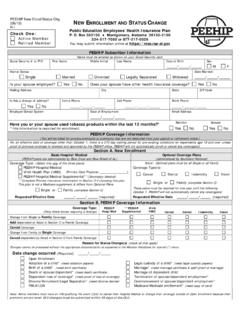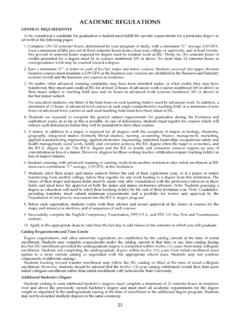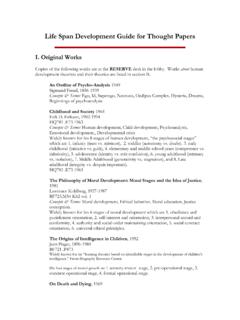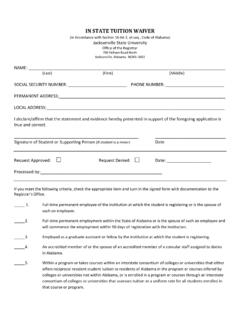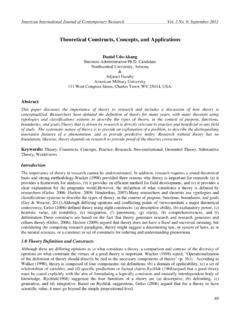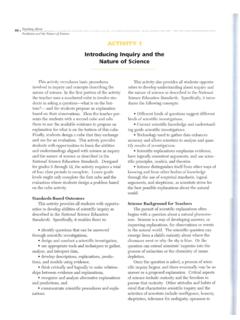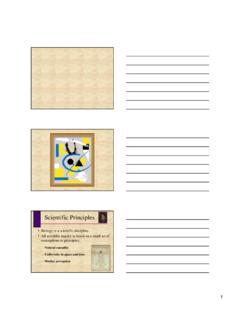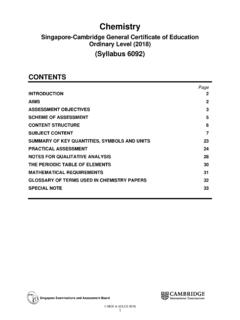Transcription of Definition of Science - jsu.edu
1 Chapter 2 - CF1 CHAPTER 2 Definition of of understanding of ScienceA. Research to understand (pure research)B. Research to solve a particular problem (applied research)C. Dispensing solutions (practitioner / technologist) III. Lexical Definitions of Science IV. Activities of a phenomenon1. type of activity2. type of explanationB. casual manipulation of empirical variables1. type of activity2. type of explanationC. specification of functional relationships1. type of activity2. type of of coherent explanatory system1. type of activity2. type of of a general and integrated mechanism of prediction (law)1. type of activity2. type of explanation V. Assumptions of Science VI. Proscriptions of ScienceVII. Misconceptions About Driving ScienceChapter 2 - CF2 : The Mechanism Underlying the Success ofScienceA. The Structure of Scientific Revolutions role for history2. the route to normal science3the nature of normal science4.
2 Normal Science as puzzle solving5. the priority of paradigms6. anomaly and the emergence of scientific discovery7. crisis and the emergence of scientific revolutions8. the response to crisis9. the nature and necessity of scientific revolutions as changes of world view invisibility of revolutions resolution of revolutions 13. progress through revolution Case history of a scientific revolutionChapter 2 - CF3 CHAPTER 2 Definition of ScienceThis section is to give you more information about Science so you can knowmore about doing and understanding those things which make you ethical andprosperous. In the previous section we saw that Science is the word for the humanactivity which produces being ethical and prosperous. This section is a morecomplete elaboration of the process of Science . This section is provided becausethe more you know of the tool Science , the better you can use it to accomplishyour ends.
3 This systematic elaboration of the process can be accomplished by wayof elaborating the Definition of Science . Science is very much more complex than pat definitions which you canmemorize and then put the issue away. The scientific method is what has evolvedto help people tell the truth and to understand the world. The followingdefinitions are attempts at applying words to what is done so that you can gainthe knowledge through vicarious experience rather than actual experience (thehard way). I. Products of which are known to be trueEmpiricalReliableMultiple Converging EvidenceConsensually ValidatedOperationally/functionally describedExplicitOntologically ValidReferential CorrespondenceTestableMinimal ErrorSystematicComprehendibleChapter 2 - CF4B. UnderstandingKnowing the relationship of facts to each other so that you can:DescribePredictControlSynthesizeExpl ainTruthfulExplicitTestableMinimal ErrorComprehendibleSystematic or Principled II.
4 Goals of ScienceThe process of Science typically has one of three Research to Understand (pure research)Pure research is concerned with developing valid, complete, and coherentdescriptions and explanations. It is interested in organizing data into the mostgeneral and parsimonious laws or qualified statements of uniformity. Theemphasis is on comprehension or understanding . It is motivated by curiosity andinquisitiveness about natural phenomena. It is interested in data andrelationships for their own sake. Most often the details of the research areconsidered arbitrary; the fundamental process is the focus. Pigeons pecking forfood is the arbitrary, irrelevant aspect; behavior under the control of reinforcers isthe important point. Doing this type of research is like learning a language; onceit is known, all things can be done. Benjamin Franklin was engaged in pureresearch when he tried to compare lightening with static electricity generated byfeet rubbing on a rug.
5 He did not do it to find a better way to illuminatePhiladelphia at night nor how to transmit TV pictures. He just wanted to know. It is interesting to note that 200 years later, few Americans wouldsurvive a single year if electricity suddenly disappeared altogether. The practicalimpact of his indulgence of his curiosity is almost unimaginable. His discoveriesare all the more impressive considering that his only reason was to add to theknowledge base. He did not do it for the money. He would not have had an answerto a critic who asked just how will this help the human condition and if you don'tknow, then you should do something more practical. Studying the nature of cellChapter 2 - CF5growth would be pure research. Trying to describe and understand thedeterminants of matching would be pure research. B. Research to Solve a Particular Problem (applied research)Applied research is concerned with the discovery of solutions to practicalproblems and places its emphasis upon those factual data which have moreimmediate utility or application.
6 The emphasis is on control. Applied researchis like learning phrases needed to accomplish a variety of specific things in aforeign language without really understanding the whole language. The searchfor a cure for cancer is an example of applied research; discovering a solution formanic depression is an example of applied research. Solutions (practitioner / technologist)Practitioners are concerned with the direct application of principles andtheories from one or more fields of Science for the purpose of dispensing solutionsto individual human problems rather than being concerned with the discoveryand organization of knowledge. Strictly speaking, a practitioner is not ascientist, but that is not to say they are necessarily unscientific. Practitioning islike memorizing sounds of a song in a foreign language without necessarilyknowing the language. It accomplishes an immediate specific end.
7 While apractitioner may uncover a phenomenon of great importance to theunderstanding of nature, that is not their primary focus. A practitioner ortechnologist administers chemotherapy or psychotherapy. A physician or apsychotherapist is a practitioner. III. Lexical Definitions of ScienceThese dictionary-type definitions are not laid down by some authority suchthat if you stay within the letter of a Definition then you are correct and are calleda scientist. They attempt to communicate with 25 words or less what Science isall about. Science uses unconfounded empirical tests to develop, discover, and explainsystematic frameworks within which relationships can be explored. Science is a knowledge generating activity which is based on systematicallyorganized bodies of accumulated knowledge obtained through objectiveobservations. Science is not so much concerned with accumulating highly precise andspecific data (although it is necessary) but rather Science seeks to discoverChapter 2 - CF6uniformities and to formulate statements of uniformities and consistencies ofrelationship between natural phenomena.
8 Science is to understand, explain, and predict by specifying the systematicrelationships among empirical variables. It must be consensually valid andgeneral. It must not be on authority, sloppy, or simply to better mankind. IV. Activities of ScienceScience can also be defined in terms of the activities of its activities and their explanatory system differ somewhat depending on thestage of maturity of the research Noticing a of ActivityUnsystematic specification of events. The beginnings of a conceptualizationof the problem or issue. Separation of occurrence from nonoccurrence (nominalscaling). Defining and specification of elements. Formulation of productivequestions. Design of subsequent of ExplanationNo explanation at all or simply general, qualitative, correlative explanationswith only analogic Manipulation of Empirical of ActivityManipulations applicable to other investigations, art what happens if I doxxxxx.
9 Isolated measurement. Measurement of variables. Description of thestatic and dynamic properties of the phenomenon. Ordinal - ratio of of ExplanationGeneral qualitative correlative explanations with slightly more than 2 - of Functional of ActivityInformal. Difficult to articulate programmatic rationale but easy to getconsensual validation of acceptable procedures and data. Meaningfulclassification and summarization. Parameter estimation. Extension to newareas. Delineation of rules. Development of theory. Discussion of theimplications. Specification of a thing's relationship with of a thing's controlling of ExplanationExplanation by specification of network of relationships. Documentation ofhow elements are interrelated and the functional relations among them. Theemergence of quantitative of Coherent Explanatory of ActivitySpecify a thing's controlling factors, and the integration of that relationshipwithin a larger framework.
10 Hypothesis testing. Formal clearly articulatedparadigmatic rational. Procedures obvious. Formation of predictions and thedevelopment of generalizations. Hypotheses formed and tested. Whensuccessful, the theory is upheld; when if fails, the theory is of ExplanationExplanations by theory. A theoretical model is advanced which specifies howelements are of a General and Integrated Mechanism ofPrediction (Law) of ActivityApply rules to solve known problem or show how obtained data are examplesof law (normal Science ). Development of applications. Synthesis of newbehaviors. Extend solution to new problem. Realize new of ExplanationThe law is used to explain other behaviors. The law has paid its dues. Anycounter examples are seen as the result of the operation of some other factors. Agreat many observations support it and virtually no findings are inconsistentwith the 2 - of ScienceAs an alternate way to communicate the nature of Science , its basicassumptions can be specified.


